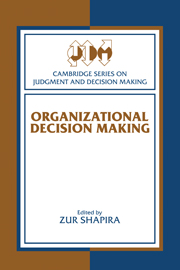Book contents
- Frontmatter
- Contents
- Series preface
- List of contributors
- Editor's preface
- Part I Introduction
- Part II Information processing and attention allocation
- Part III Preference processing
- Part IV Decision processes
- 9 The escalation of commitment: An update and appraisal
- 10 The possibility of distributed decision making
- 11 Aligning the residuals: Risk, return, responsibility, and authority
- 12 Organizational decision making as rule following
- Part V Alternative approaches
- Name index
- Subject index
10 - The possibility of distributed decision making
Published online by Cambridge University Press: 06 August 2010
- Frontmatter
- Contents
- Series preface
- List of contributors
- Editor's preface
- Part I Introduction
- Part II Information processing and attention allocation
- Part III Preference processing
- Part IV Decision processes
- 9 The escalation of commitment: An update and appraisal
- 10 The possibility of distributed decision making
- 11 Aligning the residuals: Risk, return, responsibility, and authority
- 12 Organizational decision making as rule following
- Part V Alternative approaches
- Name index
- Subject index
Summary
Increasingly in organizations, the information and authority for critical decisions are distributed over geographically separated individuals or groups. Such distributed decision making can be found in such diverse settings as voluntary organizations, multinational corporations, diplomatic corps, government agencies, and even married couples managing a household. This chapter analyzes how the distributed character of these systems affects their core cognitive activity: making decisions. As an organizing device, the chapter develops a general task analysis for distributed decision-making systems, detailing the performance issues that accrue with successive levels of complication as one goes from the simplest situation (involving a single individual possessing complete information about a static situation) to the most complex (with heterogeneous, multiperson systems facing dynamic, uncertain, and hostile environments). Drawing on experience with several such systems and on research in various disciplines, the analysis suggests both problems and possible solutions. It also derives some general conclusions regarding the design and management of distributed decision-making systems, as well as the asymptotic limits to their performance.
By starting simple, the analysis reflects a bottom-up view of organizations, focused on the properties that emerge as a result of complicating the roles assigned to the individuals in them. It also treats diverse circumstances in the same general terms. Its application to specific circumstances would obviously require more detailed analyses, perhaps beginning with classes of systems (e.g., those undergoing endogenous technological change).
- Type
- Chapter
- Information
- Organizational Decision Making , pp. 216 - 237Publisher: Cambridge University PressPrint publication year: 1996
- 1
- Cited by



